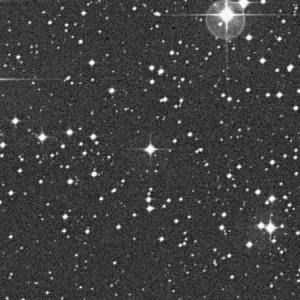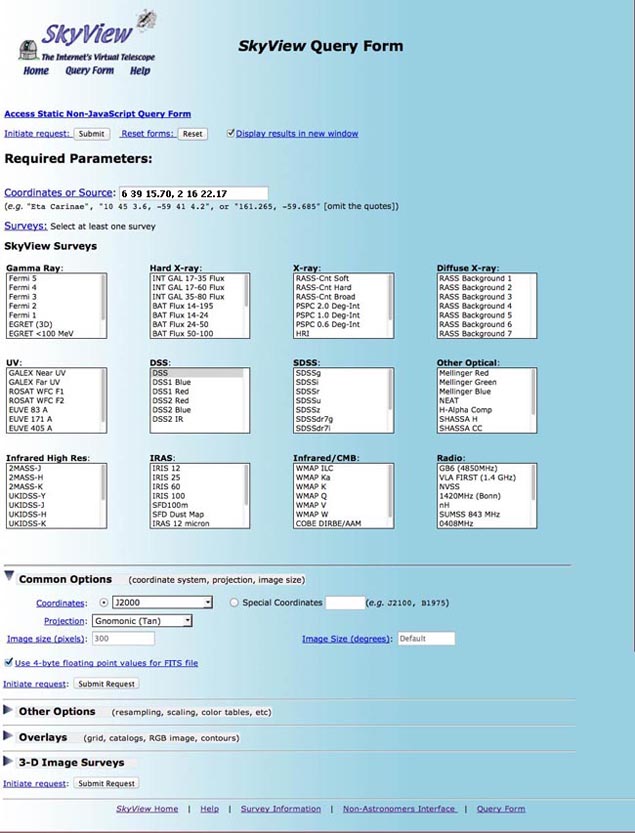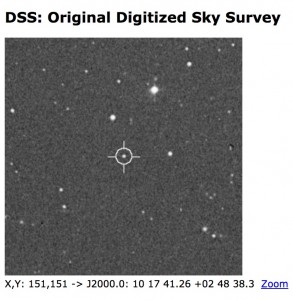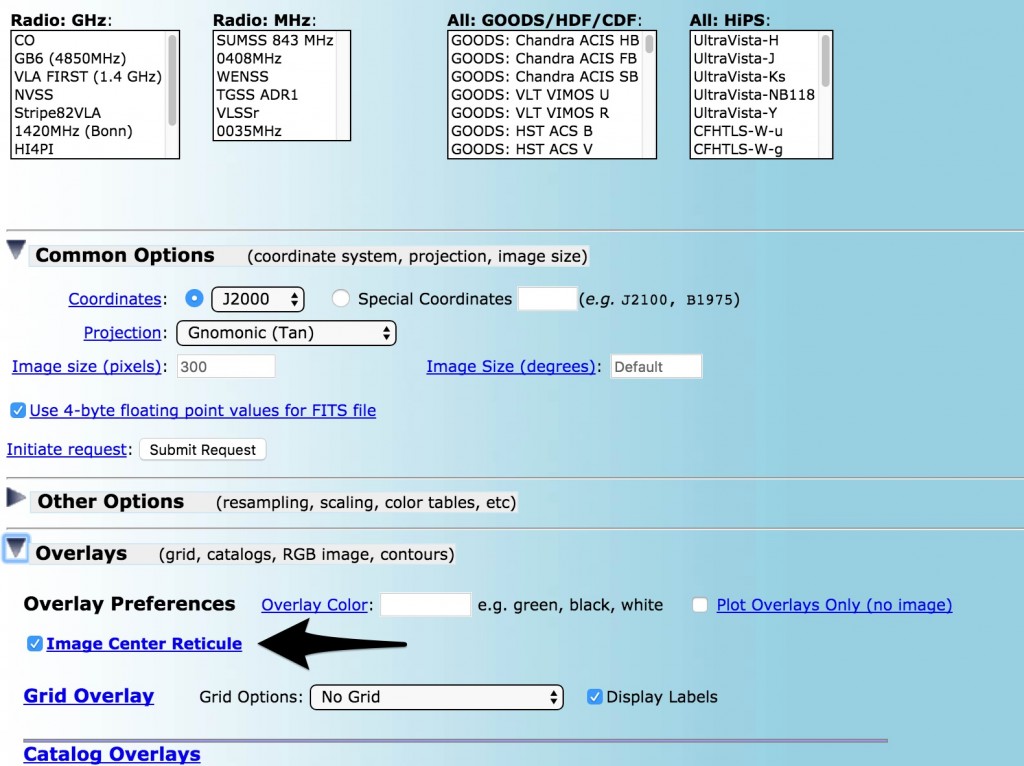We often receive email messages asking for help finding a star. In this post we will give instructions for displaying an image of a star in SkyView, as well as provide further tips for finding the star on a star chart and determining the star’s constellation and one final note about purchasing a star.
Instructions for generating an image of a star:
1. To generate an image in SkyView you’ll need a set of coordinates – the star’s right ascension and declination. These are the stellar equivalent of the latitude and longitude on the Earth. These may be in various formats but the RA usually is given as three numbers – hours, minutes and seconds. The first is between 0 and 23, the second between 0 and 59 and the third between 0 and 60. The third number, the seconds, may contain a fractional part. The Declination is similar, but the the first number can range between -90 and 90 and is called degrees not hours.
For SkyView these coordinates may need to be converted to a format containing just hours, minutes, seconds or decimal numbers. They can be separated by a comma or the sign for the declination (more information)
An example of a set of coordinates: RA: 6h 39m 15.70s DEC: 2 16′ 22.7″
The SkyView format of this set of coordinates would be:
6 39 15.70, 2 16 22.17 or 6 39 15.70 +2 16 22.17
Coordinates in this format can be used in the SkyView Query form.
Enter the coordinates in the Coordinates or Source input box.
2. Next a SkyView Survey needs to be selected. The SkyView Query form provides many surveys in many wavelengths. Typically someone trying to find a star will want to see how it appears in the night sky so an optical survey is best. The best survey to start with is the Digital Sky Survey (DSS) which is at the top of our DSS survey category.
3. Once at least one survey is selected and coordinates are entered the user can click the Submit button and an image of the sky centered on the coordinates will be displayed.
Below is a partial image of the SkyView Query Form showing the coordinates entered in the Coordinates or Source box and the DSS survey selected. Below the form is an image of the star that displays after the form is submitted.
SkyView Query Form

SkyView Image centered at 6 39 15.70 +2 16 22.17
The SkyView Query Form has many other options for manipulating the SkyView image to change image size, image colors, resampling, projections, coordinate systems or to add contours and other overlays. These are just a few of SkyView‘s features. An example would be the option to mark the center of an image with a circle. Apply this feature in the Overlays section of the Query Form (see below). Check the Image Center Reticule option before submitting the query.
Related Tips:
There are many websites that provide sky charts for a particular location and information about constellations. Here are two of these sites we have found useful:
http://djm.cc/constellation.html: A simple form that displays the name of the constellation for specified coordinates
http://vizier.u-strasbg.fr/vizier/VizieR/constellations.htx#q: Displays boundaries for constellations. Enter coordinates below the list of constellations.
http://www.fourmilab.ch/yoursky: Get images of entire sky as viewed from a given location at a specified time and date. Their Virtual Telescope shows constellations and other objects at specified coordinates.
http://www.heavens-above.com: Get sky charts and satellite schedules as seen from specified locations. This site also gives the time in various time zones/formats (local time, GMT, UTC)
https://simbad.u-strasbg.fr: If you want to find more information about a star, Simbad is often a good place to start. If you enter the position in the position search you’ll find a list of nearby objects. If there’s more than one, click on the nearest to your position and you’ll get information on measurements of the star: brightness, parallax (3261/parallax in mas is the distance in lightyears), and spectral type. With the help of astronomical text books, you can use the last to get an estimate the diameter and mass of the star. Occasionally those are directly measured too.
A Final Note:
Many of these requests for help finding a star come from people who have purchased or received a gift of a star from a registry service. No star registry services are recognized by any political or scientific authorities. More information can be found at http://www.iau.org/public/buying_star_names/




Hi Abigail,
My first response had an error in the coordinates.
Try again (without the ‘DEC:’) using: 0h 55m 0.85s, 12 50 50.6
Sorry for the confusion.
-Laura
Hi Laura
The image came up, thank you.
How would I use said information to locate the star in the sky?
Thank you for all your help
Hi Abigail,
I see from this site: http://djm.cc/constellation.html that the star is in Pisces. (use this format: 0 55 0.85 +12 50 50.6)
Depending on where you are in the world you may or may not be able to see Pisces at night at this time of year.
A good site that can help is Heavens Above . Click on the “Unspecified” link next to “Location” in the upper right corner and enter your location and click the Search button. Then click the Update button below the map.
This should take you back to the main page. Click on the “Interactive sky chart” link under Astronomy. This will show you a sky chart for your location. Change the time at the top (to a night time) and update to see the constellations that are visible at that time.
I am sure there are other websites that can help with this as well.
-Laura
Hi
Would you please help me. I am having a really hard time locating my late husbands star or any info on it. I am getting rather frustrated.
The coordinates are 6hr 25m 7.9sec +o 11′ 0.6″
I hope to hear back from you. Thank You.
Hello,
On the SkyView Query Page enter the coordinates in the “Coordinates or Source” box using the following format: 6 25 7.9, 0 11 0.6
Then select the DSS or DSS2 surveys in the the “DSS: Optical” survey box.
Then click the “Submit” button at the top of the form.
An image will be displayed centered on your coordinates.
If you have further questions let me know.
I am sorry for your loss.
Laura McDonald
SkyView
I have the coordinates 8 19 33 42+ 14 44.70 I know it’s n the sky but is it over land or water. Idk much about this. Where is located above earth besides in the sky. Thank you so much.
hi i have to look find a star
To determine if you can see the object at your coordinates you might try the services at the site: http://www.fourmilab.ch/yoursky/
The Virtual Telescope (bottom of page) van help you determine in which constellation the coordinates are located. The other forms on this page can help you determine what part of the sky you can see from your location on earth.
I hope this helps.
-Laura
SkyView
Hello,
If the blog post or the comment responses at the bottom of the blog post don’t help you can send us your coordinates and we can try to help.
-Laura
SkyView
All the apps I’ve used I can figure this out. Trying to find. 17h 48m 33.5s 48° 15′ 38.5″
Hello Jennifer,
Try this format
17 48 33.5, 48 15 38.5
in the Coordinates box on the SkyView Query page and select DSS under Optical:DSS. An image from the Digitized Sky Survey will be displayed centered on your coordinates.
Let me know if you have further questions.
Regards,
Laura
SkyView
Perfect information about how to coordinate a star but it will be possible through RA and declination should be conditionable.
Hi can anyone help me with this?
Is it possible for me to show my fiancé our star somehow? By either taking him to a place that can help us find it with a telescope or at least by being able to show a picture? The coordinates are RA: 12h24m51.82s DEC: +51 27′ 54.6″
If you have not already done so go to the SkyView Query Page and enter the coordinates in the “Coordinates or Source” box using the following format: 12 24 51.82, 51 27 54.6
Then select the DSS or DSS2 surveys in the the “DSS: Optical” survey box. Then click the “Submit” button at the top of the form. An image originating from a telescope survey of the sky will be displayed centered on your coordinates.
To determine if you can see the object at your coordinates you might try the services at the site: http://www.fourmilab.ch/yoursky/
The Virtual Telescope (bottom of page) van help you determine in which constellation the coordinates are located. The other forms on this page can help you determine what part of the sky you can see from your location on earth.
I hope this helps.
-Laura
SkyView
Hi.
i would like help in locating a Star.
Right ascension 20h 3m 46.11s
Declination 4degrees 51′ 35.03″
Thank you, Amy
Good evening,
I got a star for my husband, please help we can’t find it
15h 32m 55.20s, 16d 51m 10.1s
HR 5764
Hiya I have no idea how to do this I have
0h 22m 26.30s 22° 42′ 0.16 any help would be grateful thanks.
Hi Simon,
Try this format
0 22 26.30, 22 42 0.16
in the Coordinates box on the SkyView Query page and select DSS under Optical:DSS. An image from the Digitized Sky Survey will be displayed centered on your coordinates.
If you have further questions please take a look at the comments section of the post or let me know.
Regards,
Laura McDonald
SkyView
Hello Nicolette,
There appears to be a typo in the coordinates for the star (HR 5764) you listed. HR 5764 is located at 15 32 55.22,-16 51 10.3
You can enter the star name HR 5764 (or the coordinates) in the Coordinates box on the SkyView Query page and select DSS under Optical:DSS. An image from the Digitized Sky Survey will be displayed centered on the star.
If you have further questions please take a look at the comments section of the post or let me know.
Regards,
Laura McDonald
SkyView
Hello Amy,
Try this format
20 3 46.11, 4 51 35.03
in the Coordinates box on the SkyView Query page and select DSS under Optical:DSS. An image from the Digitized Sky Survey will be displayed centered on your coordinates.
If you have further questions please take a look at the comments section of the post or let me know.
Regards,
Laura McDonald
SkyView
Thank you for your information.I really liked your blog. Really looking for your site really very nice
i impressed for your blog.very use ful because i improve the knowledge.
information and knowledge of your article really nice and helped us, I thank you.
Can you please help me locate this star
Coordinates 8 480 38:5800 (rectascension)
9:1933 (declination
Magnitude 15:14mag
Thanyou
Hello Chaitrali,
Try this format
8 48 38.48, 9.1933
in the Coordinates box on the SkyView Query page and select DSS under Optical:DSS. An image from the Digitized Sky Survey will be displayed centered on your coordinates.
If you have further questions please take a look at the comments section of the blog post or let me know.
Regards,
Laura McDonald
SkyView
HELP I have no idea how to fill out the skyview query page what do I need to do, my coordinates for my star are RA- 11:20:4.81 and DEC +38:05:18.7 Please email me back soon I would really like to check out my star. Also I got a picture of where my star is located it’s showing that it is between Ursa Major,Leo Major,Leo,Canes Venatici I live in Texas and want to know if I can see it from my location with the naked eye or do I need a telescope or if I can see it at all to view it I hope this makes since and that you can help thank you
Hello Shelia,
Try this format
11 20 4.81, 38 05 18.7
in the Coordinates box on the SkyView Query page and select DSS under Optical:DSS (or any other optical survey). An image from the survey you choose will be displayed centered on your coordinates.
Use the Sky Map section at https://www.fourmilab.ch/yoursky/ to see a diagram of the sky at your location. Select the city in the list closest to your location. When the map is displayed you can adjust the time to your observing time.
If you have further questions please take a look at the comments section of the blog post or let me know.
Regards,
Laura McDonald
SkyView
Good post, keep
Great information of how to coordinate a star but it will be possible only through RA. I have been trying to find 14h 50m 33.5s 48° 14′ 35.5″
Hello,
On the SkyView Query Page enter the coordinates in the “Coordinates or Source” box using the following format: 14 50 33.5, 48 14 35.5
Then select the DSS or other surveys in the “DSS: Optical” survey box.
Then click the “Submit” button at the top of the form.
An image will be displayed centered on your coordinates.
If you have further questions let me know.
Laura
SkyView
Hi there,
I was wondering if you could help. My star co-ordinates are written as 12:58:00.803-17:40:51.66 could you please help me to format it in a way that I will be able to see my star its very important to me.
Thank you!!
First time ive been on here. I greatly appreciate all that’s shared.
Hi I have 2 stars registered with names and I am trying to get a view of them WITH an overlay of the constellations ontop, is this possible please? The 2 star positions are as follows:
First star:
Right ascension 12h 33m 24.16s
Declination 61. 0’ 42.77”
Second star:
Right ascension 8h 45m 17.54s
Declination 60.43’ 27.01”
Hope you can help
I have a star I bought the info I was given was it’s located at
RA 51.10948374 and Declination 40.07124662
Please help me find an image of it
Plz help me to find out the coordinate for AGB stars
Hello i named a star after my brother in law that passed recently, having trouble to find it could you please help.
RA:5h41m34.03s DEC;-1°56’16.8″
Hi, I have co-ordinates for a star. I know how to find it and look at it. I am actually looking for a way to find out what TYPE of star it is. There should be a way to tell that? The co-ordinates are: RA 13:03.10.18, DEC -43:59.15.94
Really appreciated post. This information will help to others. Thanks and keep posting. Good luck.
Hello,
I apologize that we have not gotten back to you sooner.
There are several resources for getting information about objects at or near your coordinates.
The NASA/IPAC Extragalactic Database is a good place to start: https://ned.ipac.caltech.edu/?q=nearposn
Enter your coordinates in the RA and DEC areas as: 13 03 10.18 and -43 59 15.94
You will get a list of nearby sources with the closest at the top. If you click on the name in the Name Column you will be given more information about the source.
Another resource is SIMBAD http://simbad.u-strasbg.fr/simbad/sim-fcoo. Enter your coordinates as 13:03:10.18-43:59:15.94
I hope this information is helpful.
Laura
SkyView
Hello Lisa,
I apologize that we have not gotten back to you sooner.
On the SkyView Query Page enter the coordinates in the “Coordinates or Source” box using the following format: 5 41 34.03,-1 56 16.8
Then select the DSS or other surveys in the “DSS: Optical” survey box.
Then click the “Submit” button at the top of the form.
An image will be displayed centered on your coordinates.
I took a look at the resulting images and do not see a star right at the center. If you see that there is a typo in the coordinates you were given let me know and I can convert them to the SkyView format.
If you have further questions let me know.
We are sorry for your loss.
Sincerely,
Laura
SkyView
I absolutely love your blog.It is more informative and useful to the readers.Thanks for sharing this knowledgeable content, will be looking forward to your future updates.
Hello, this maybe a silly question but I was just wondering where in the world could I view the star RA 2.321 +21.07, I don’t mind popping into an observatory but if I’m in the wrong county I’d like to get to the right spot.
This position is observable in principle from anywhere on the Earth except Antarctica.
If you live in the continental US, then every day it passes quite high in the sky. Right now it
would be highest in the sky at about midnight. It will pass (Lat-21.07) degrees south of directly
overhead, where Lat is your latitude. Each night it this will happen about four minutes earlier, so that
over the course of a year it will be uniformly spaced over the 24 hour day.
Regards,
Tom McGlynn